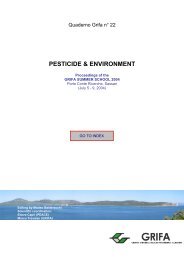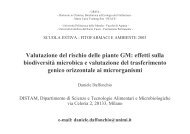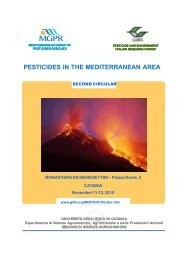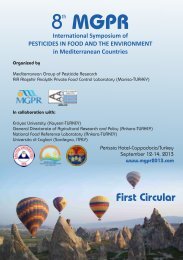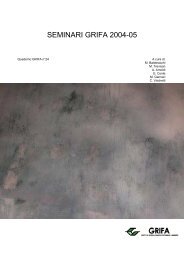International Congress BIOLOGICAL PRODUCTS - Gruppo di ...
International Congress BIOLOGICAL PRODUCTS - Gruppo di ...
International Congress BIOLOGICAL PRODUCTS - Gruppo di ...
Create successful ePaper yourself
Turn your PDF publications into a flip-book with our unique Google optimized e-Paper software.
Results and Discussion<br />
S. carpocapsae was <strong>di</strong>fferentially stimulated to be attracted to G. mellonella volatiles by the contact of the<br />
cuticle of <strong>di</strong>fferent arthropods. Agrotis ipsilon pupa, Leptinotarsa decemlineata, Isopoda sp., Blattella<br />
germanica, Musca domestica and Diplopoda sp. were not significantly <strong>di</strong>fferent from the controls. A. ipsilon<br />
larva, Tenebrio molitor, Acheta domesticus, G. mellonella, Diabrotica virgifera virgifera and Popilia japonica<br />
induced a significantly higher "activation" to S. carpocapsae IJs compare to the controls. It seems that S.<br />
carpocapsae can <strong>di</strong>scriminate even among <strong>di</strong>fferent stage of the same species in fact the value of A. ipsilon larva<br />
is more than twice that of the pupa.<br />
The same hosts that induced the higher attraction to the volatiles were more susceptible to the nematodes.<br />
The nematodes, established (penetration rate and reproduction index) better in the group of arthropods that<br />
where better stimulated by G. mellonella volatiles.<br />
It has been demonstrated that, at least one entomopathogenic nematode, S. carpocapsae, could <strong>di</strong>scriminate<br />
among suitable and not suitable hosts.<br />
Figure 1: Agar Plate Arena<br />
Glass plate<br />
G. mellonella larvae<br />
Pipette<br />
tip<br />
Chamber with gra<strong>di</strong>ent<br />
Nematodes<br />
Agar substrate<br />
Rubber<br />
c) Laboratory results toward non-target hosts:<br />
Application point of nematodes<br />
The non-insect organisms, earthworms, scorpions and millipedes have been challenged with <strong>di</strong>fferent strains of<br />
entomopathogenic nematodes.<br />
Material and methods<br />
Hosts: the non-insect organisms, earthworms, scorpions and millipedes have been captured under stones, and<br />
stored at 12°C for 24 hours prior the experiment.<br />
Nematodes: were reared in Galleria mellonella last instar larvae by standard rearing procedures.<br />
For earthworms the following nematode strains were tested: Heterorhab<strong>di</strong>tis bacteriophora NJ, Steinernema<br />
kraussei N0093 and S. feltiae UK.<br />
For Scorpions and Millipedes: H. bacteriophora NJ, S. kraussei N0093, S. sp. N0166, S. sp. N0167, S. sp.<br />
N0168, H. sp. N0169, H. sp. N0170. The infectivity of nematodes was tested in parallel on 100 mg larvae of<br />
Tenebrio molitor (10 larvae per box with 1500 nematodes). There were 3 repetitions per treatment. Incubation<br />
was done at 23°C for 5 days. Controls (only water) were always included.<br />
Tests with Earthworms: in 10x7x5 cm plastic boxes, 50 g of peat with 75% humi<strong>di</strong>ty, 5 earthworm were<br />
challenged with 3000 infective nematodes. There were 3 repetitions per treatment. Incubation was done at 23°C<br />
for 7 and 14 days.<br />
Tests with Millipedes: in 10x7x5 cm plastic boxes, 50 g of peat with 75% humi<strong>di</strong>ty, 3 millipedes were<br />
challenged with 1500 infective nematodes. There were 3 repetitions per treatment. Incubation was done at 23°C<br />
for 5 days.<br />
Tests with Scorpions: they were tested in Petri <strong>di</strong>shes with 3000 nematodes per in<strong>di</strong>vidual for 5 days at 23°C.<br />
Results<br />
Mortality of Earthworms challenged with entomopathogenic nematodes (see Tab. 1) <strong>di</strong>d not <strong>di</strong>ffered among<br />
treatments both at 7 (P=05957) and 14 days (P=0,7520).<br />
129<br />
Plexiglas lid<br />
PDF creato con FinePrint pdfFactory versione <strong>di</strong>mostrativa http://www.secom.re.it/fineprint



